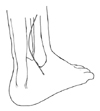Abstract
Purpose
For fixation of the large posterior malleolar fracture fragment, indirect anterior fixation with cannulated screw has been widely used, but the anatomical reduction is not always obtained. The purpose of this article is to evaluate the clinical result of posterior malleolar fractures treated with anatomical reduction and internal fixation using posterior approach.
Materials and Methods
We have analyzed the 15 patients with posterior malleolar fractures, treated with posterior approach from August 2005 to August 2008. The mean follow up period was 17.6 months, We have reviewed the perioperative joint integrity, method of operation, postoperative care, bony union and complication. A clinical outcome was evaluated by AOFAS (American orthopedic foot and ankle society) scaling system and Olerud & Molander scoring system.
Results
Among 15 cases, posterolateral approach and posteromedial approach were chosen in 9 cases and 6 cases respectively. The radiologic unions were achieved at 12.4 (12~18) weeks. Mean AOFAS score was 90.3 (72~98), and Olerud & Molander score was "excellent" in 5 cases, "good" in 7 cases, "fair" in 1 case and "poor" in 2 cases. Postoperative complications in 2 cases revealed a posttraumatic arthritis and a scar band contracture respectively.
Conclusion
In posterior malleolar fracture of ankle joint, the integrity of joint has closely affected clinical outcomes. We suggest that a posterior approach for posterior malleolar fracture with especially incarcerated fragments and comminuted fractures, can be a useful method for anatomical reduction and stable fixation, and satisfactory clinical results.
Figures and Tables
Fig. 1
Posterolateral approach to the posterior malleolar fracture. Intraoperative finding showing fixation of posterior malleolus using plate and screws.

Fig. 3
(A) Preoperative CT image showing posterior malleolar fracture with displacement and incarcerated bony fragment.
(B) Postoperative lateral radiograph showing anatomical reduction of posterior malleolus.

Fig. 4
(A) Preoperative sagittal CT image showing posterior malleolar fracture with comminution.
(B) Postoperative lateral radiograph showing reduction and stabilization with plate and screws (C) 1 year follow-up sagittal CT image showing incongruity of joint.
(D) 2 year follow-up lateral radiograph with arthritic changes.

References
1. Bae SY, Shin DH. The role of posterior malleolar fragments in ankle pain after trimalleolar fractures. J Korean Soc Fract. 2003. 16:59–66.

2. Fitzpatrick DC, Otto JK, McKinley TO, Marsh JL, Brown TD. Kinematic and contact stress analysis of posterior malleolus fracture of the ankle. J Orthop Trauma. 2004. 18:271–278.

3. Hartford JM, Gorczyca JT, McNamara JL, Mayor MB. Tibiotalar contact area. Contribution of posterior malleolus and deltoid ligament. Clin Orthop Relat Res. 1995. 320:182–187.
4. Huber M, Stutz P, Gerber C. Open reduction and internal fixation of the posterior malleolus with a posterior antiglide plate using a posterolateral approach: a preliminary report. Foot Ankle Surg. 1996. 2:95–103.

5. Jaskulka RA, Ittner G, Schedl R. Fractures of the posterior tibial margin: their role in the prognosis of malleolar fractures. J Trauma. 1989. 29:1565–1570.
6. Kang CN, Kim JO, Lee SB, Kang OY, Shin MS. Treatment of the posterior lip fracture of distal tibia using posteromedial approach. J Korean Soc Fract. 1995. 8:594–599.

7. Kitaoka HB, Alexander IJ, Adelaar RS, Nunley JA, Myerson MS, Sanders M. Clinical rating systems for the ankle-hindfoot, midfoot, hallux, and lesser toes. Foot Ankle Int. 1994. 15:349–353.

8. Langenhuijsen JF, Heetveld MJ, Ultee JM, Steller EP, Butzelaar RM. Results of ankle fractures with involvement of the posterior tibial margin. J Trauma. 2002. 53:55–60.

9. Lee CS, Suh JS, Yi JW. Comparative study for the results of ankle fracture depending on the extension of the posterior malleolus fracture. J Korean Orthop Assoc. 2007. 42:470–474.

11. Lindsjö U. Operative treatment of ankle fracture-dislocations. A follow-up study of 306/321 consecutive cases. Clin Orthop Relat Res. 1985. 199:28–38.
12. Macko VW, Matthews LS, Zwirkoski P, Goldstein SA. The Joint-contact area of the ankle. The contribution of the posterior malleolus. J Bone Joint Surg Am. 1991. 73:347–351.

13. McDaniel WJ, Wilson FC. Trimalleolar fractures of the ankle. An end result study. Clin Orthop Relat Res. 1977. 122:37–45.
14. Olerud C, Molander H. A scoring scale for symptom evaluation after ankle fracture. Arch Orthop Trauma Surg. 1984. 103:190–194.

15. Papachristou G, Efstathopoulos N, Levidiotis C, Chronopoulos E. Early weight bearing after posterior malleolar fractures: an experimental and prospective clinical study. J Foot Ankle Surg. 2003. 42:99–104.

16. Talbot M, Steenblock TR, Cole PA. Posterolateral approach for open reduction and internal fixation of trimalleolar ankle fractures. Can J Surg. 2005. 48:487–490.




 PDF
PDF ePub
ePub Citation
Citation Print
Print




 XML Download
XML Download